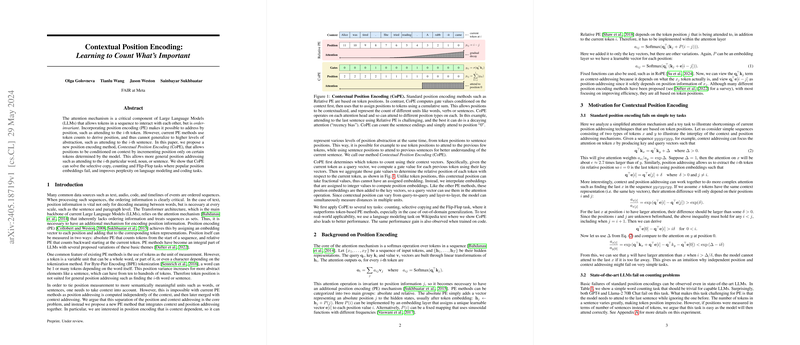Contextual Position Encoding: Learning to Count What's Important
The paper "Contextual Position Encoding: Learning to Count What's Important," by Golovneva et al., addresses a fundamental limitation of current Position Encoding (PE) methods in LLMs. The paper introduces "Contextual Position Encoding" (CoPE), a novel method that allows for advanced position addressing conditioned on context, enhancing LLMs' ability to handle complex tasks involving higher levels of abstraction.
The attention mechanism in Transformers, which is pivotal for LLMs, does not natively incorporate position information, treating sequences as sets. Traditional PE methods, which typically use token count to derive position, fail to generalize beyond tokens to more abstract units such as sentences or specific parts of speech. To tackle this limitation, CoPE proposes a more flexible and context-aware approach to position encoding.
Key Contributions
- Context-Dependent Position Measurement:
- Unlike traditional PE methods that depend solely on token count, CoPE determines positions based on contextual significance. By computing gate values conditioned on token context, CoPE dynamically adjusts position increments, enabling the model to attend to more semantically meaningful units like sentences or specific word types.
- Improvement on Various Tasks:
- The paper demonstrates CoPE's superior performance on several tasks. In the flip-flop task, CoPE achieved significantly lower error rates compared to absolute and relative PE methods, particularly excelling in out-of-domain (OOD) scenarios. Similarly, CoPE outperformed in the selective copy and counting tasks by effectively managing the contextual positioning of tokens that traditional methods failed to address accurately.
- Theoretical and Practical Implications:
- The proposed method shows potential for better generalization in LLMing tasks, as evidenced by experiments on datasets like Wikitext-103 and a domain-specific code dataset. CoPE's ability to represent counts of abstract units like sentences enables it to address tasks that are challenging for existing models, including those that demand robust reasoning over long sequences.
Theoretical Insights
Incorporating context into position encoding bridges the gap between positional and semantic information, which is traditionally handled separately in LLMs. By devising a gating mechanism that directly interlinks positional embedding with context, CoPE offers a unified framework that can scale across various abstraction levels. This not only addresses the inefficiencies in handling variable-length units within sequences but also facilitates long-range dependencies in text, which is crucial for tasks requiring detailed context comprehension.
Empirical Results
- Flip-Flop Task:
- CoPE reduced the error rate to 0.0% in in-domain tests and achieved a substantial improvement in OOD scenarios with an error rate of 4.9%, whereas traditional methods exhibited much higher error rates.
- Selective Copy Task:
- CoPE demonstrated flawless performance with 0.0% in-distribution error and OOD error rates, starkly contrasting with the failure rates of other positioning methods.
- Language and Code Modeling:
- CoPE achieved improved perplexity on the Wikitext-103 dataset, outperforming traditional PE methods both in in-domain and extended context length evaluations. On the code modeling dataset, it also presented superior results with a test perplexity score of 3.9 against 4.1 of the RoPE.
Future Implications
The introduction of CoPE opens up a myriad of possibilities for future research:
- Enhanced Sequence Modeling:
- Models incorporating CoPE can be expected to perform better on tasks involving hierarchical structures, like paragraphs in long documents or scenes in video and speech data.
- Model Efficiency:
- By integrating context into position addressing more naturally, CoPE could streamline models, potentially reducing the need for elaborate position-specific training while enhancing their adaptability.
- Refinement and Extensions:
- Further research can explore combining CoPE with other improvements in transformer architectures, examining its effects on extensive multimodal datasets, and assessing its scalability in larger models and longer training contexts.
Conclusion
Contextual Position Encoding represents a significant advancement in the field of PE methods for LLMs. By conditioning positions on contextual information, CoPE manages to accurately encode more complex positional relationships that are vital for higher-level text and code comprehension tasks. The experimental results demonstrate substantial improvements over traditional PE methods, both in terms of performance and generalization across varied contexts, marking it a promising direction for future LLM research and applications.
